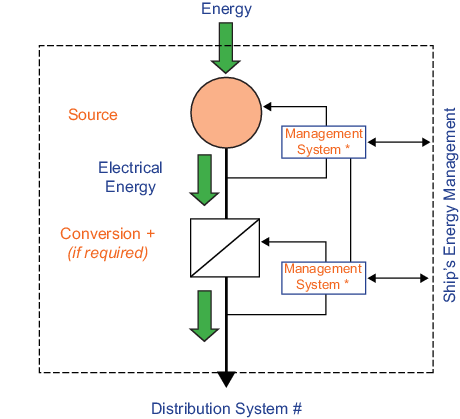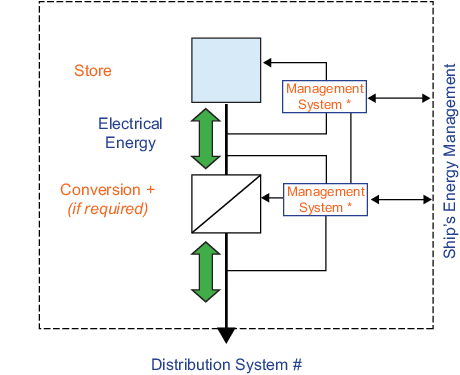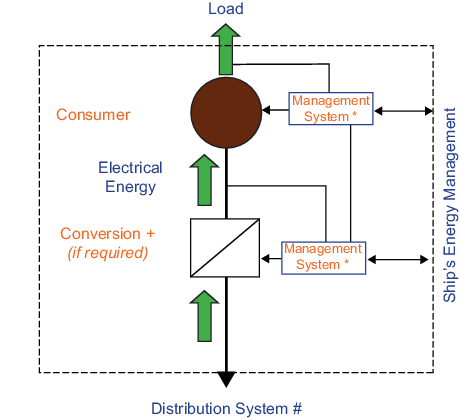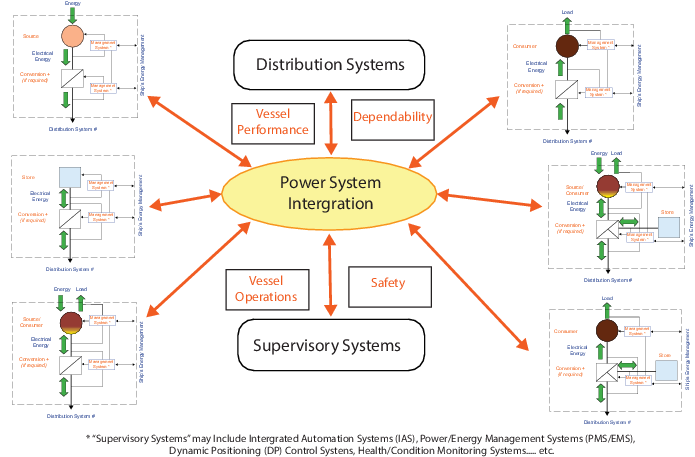
Section
3 Definitions

3.1 Hybrid electrical power systems
3.1.1 A ship’s electrical power system comprising sources, stores, consumers and
distribution of electrical power together with their associated controls within
which electrical power is provided by two or more different types of power source or
utilising stored electrical energy to satisfy the ship’s main power demand.
3.1.2 This definition is independent of:
- the type of distribution system (see
Vol 3, Pt 1, Ch 6, 3.3 Source of electrical power 3.3.1;
- the types and ratings of source, their physical location and
time duration of connection to the ship’s power system;
- the types of store;
- the types of connected consumer; and
- the presence or otherwise of electric propulsion.

3.2 Reasonably foreseeable abnormal condition
3.2.1 A reasonably foreseeable abnormal condition is an operation, event, incident or
failure that:
- has happened and could happen again;
- has not happened but is considered possible. Where the
likelihood is considered extremely unlikely or the consequences are trivial, and
no further prevention or mitigation action is to be taken, then this is to be
justified; and
- is planned for (e.g. emergency actions cover such a
situation, maintenance is undertaken to prevent it).
3.2.2 They should be identified by:
- using analysis processes that are capable of revealing
abnormal conditions;
- employing a mix of personnel including designers, Operators,
persons who carry out maintenance and competent safety/risk professionals with
relevant domain knowledge and understanding to apply the processes;
- referencing relevant events and historic data; and
- documenting the results of the analysis.

3.3 Source of electrical power
3.3.1 A source of electrical power produces electrical power from an energy
source such that its output may be connected to ship’s electrical power distribution
system (see
Figure 6.3.1 Source of electrical power).
It includes:
- Dedicated conversion where conversion is the changing of an
output with respect to its input and may include change of form (e.g. a.c. to
d.c. or d.c. to a.c.), change in magnitude (e.g. of voltage, current or
frequency), change in phase or change in reference (e.g. through galvanic
isolation);
- Management systems perform monitoring, control, protection
and safety functions that are likely to be connected to higher level ship wide
supervisory systems; and
- Systems providing control, alarm, monitoring and safety
functions such as control panel, governor, automatic voltage regulator (AVR) and
emergency shutdown (ESD) system for a reciprocating engine or gas turbine
generator.
3.3.2 This definition of source of electrical power is independent of:
- the type of source (e.g. rotating generator, waste heat
recovery system, wind generator, solar panel, fuel cell, photovoltaic
array);
- the type of distribution system (see
Vol 3, Pt 1, Ch 6, 3.3 Source of electrical power 3.3.1); and
- the application of the source (e.g.
main/additional/emergency/transitional source of power).

Figure 6.3.1 Source of electrical power

3.4 Additional source of electrical power
3.4.1 An additional source of power is a source of electrical power not forming part of the
ship’s main source of power that is rated to supply any proportion of the ship’s
main power demand at any time either continuously or for an accepted period of time,
e.g. an energy storage device or a power take-off that is not rated for or capable
of permanent operation.

3.5 Store of electrical energy
3.5.1 A store of electrical energy receives, stores and discharges energy
through a single point of common coupling with the distribution system (see
Figure 6.3.2 Store of electrical energy). It
includes management systems and any required dedicated conversion as defined in
Vol 3, Pt 1, Ch 6, 3.3 Source of electrical power.This definition is independent of:
- the method of energy storage;
- the type of store (e.g. battery, capacitor);
- the type of distribution system (see
Vol 3, Pt 1, Ch 6, 3.3 Source of electrical power 3.3.1; and
- the application of the store (e.g. power source, load
smoothing, peak shaving, dynamic response, power backup).

Figure 6.3.2 Store of electrical energy

3.6 Consumer of electrical power
3.6.1 A consumer of electrical power takes its input from the electrical
distribution system and delivers useful work through its associated load (see
Figure 6.3.3 Consumer of electrical power). It
includes management systems and any required dedicated conversion as defined in
Vol 3, Pt 1, Ch 6, 3.3 Source of electrical power.
Consumers are present in any electrical power system and are not unique to hybrid
electrical power systems. The definition is provided here for completeness. This
definition is independent of:
- the type of load or the purpose for which it is installed;
and
- the type or physical form of distribution system.

Figure 6.3.3 Consumer of electrical power

3.7 Combined sources/stores/consumers of
electrical power

3.8 Distribution system
3.8.1 The distribution system provides the interconnection between, protection of and
isolation of:
- sources (see
Vol 3, Pt 1, Ch 6, 3.3 Source of electrical power to Vol 3, Pt 1, Ch 6, 3.4 Additional source of electrical power),
- stores (see
Vol 3, Pt 1, Ch 6, 3.5 Store of electrical energy),
- consumers (see
Vol 3, Pt 1, Ch 6, 3.6 Consumer of electrical power) and
- combinations thereof (see
Vol 3, Pt 1, Ch 6, 3.7 Combined sources/stores/consumers of electrical power).
It includes management systems (e.g. power management) and any required
dedicated conversion as described in Vol 3, Pt 1, Ch 6, 3.3 Source of electrical power.
There are no constraints on its type (e.g. a.c. or d.c.), magnitude (e.g. voltage
and/or frequency), nature (e.g. fixed or variable), architecture (e.g. tree, radial,
zonal), physical form or on the number of variants within a ship.

3.9 Energy management
3.9.1 Energy management functionality provides the overall control, monitoring, protection
and safety functions that are necessary to deliver dependable electrical power from
the hybrid electrical power system in all operating modes and under both normal and
reasonably foreseeable abnormal conditions. It comprises supervisory functions that
integrate the management systems of the components (sources, stores, consumers,
distribution systems) from which the hybrid system is constructed and may be
implemented as a stand-alone system or as distributed functionality across a number
of systems.
3.9.2 Energy management is focused on energy flow and is typically model based,
predictive in nature, inclusive of optimisation functionality and employing the
principles of health and condition monitoring at system level (e.g. as described in
ShipRight Procedure for the Approval of Digital Health Management
Systems).
3.9.3 Loss of energy management functionality is not to compromise the safety of the ship,
the hybrid electrical power system or its components.
3.9.4 Energy management functionality is considered additional to the functionality of a
conventional power management system as described in IEC 60092-504, Electrical
installations in ships, Part 504: Automation, control and instrumentation,
section 9.4.

3.10 Power system integration
3.10.1 Power system integration comprises those system level activities that
are required to be undertaken to design and develop, build and then operate and
maintain safely through life a dependable ship’s hybrid electrical power system
including its constituent components (shown pictorially in Figure 6.3.8 Role of system integration activities). At each phase of a project power system integration is
managed by a single designated party and is carried out in accordance with a defined
procedure identifying the roles, responsibilities and requirements for all parties
involved.

Figure 6.3.8 Role of system integration activities

3.11 Dependability
3.11.1 Dependability is as defined in IEC 60050(191), Quality vocabulary – Part 3:
Availability, reliability and maintainability terms – Section 3.2: Glossary of
international terms. It is the collective term used to describe the
availability performance and its influencing factors: reliability performance,
maintainability performance and maintenance support performance as agreed with
LR.
|